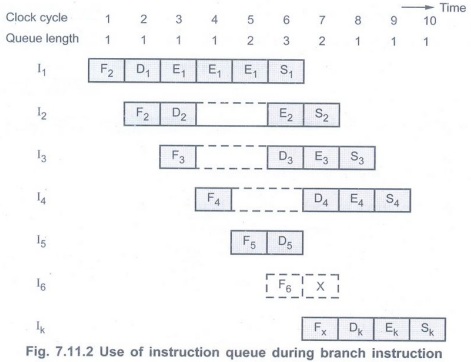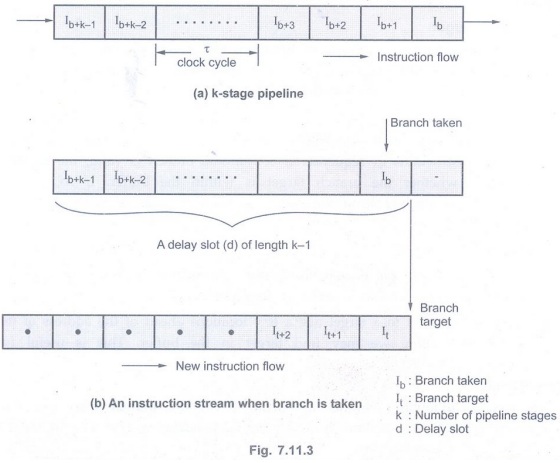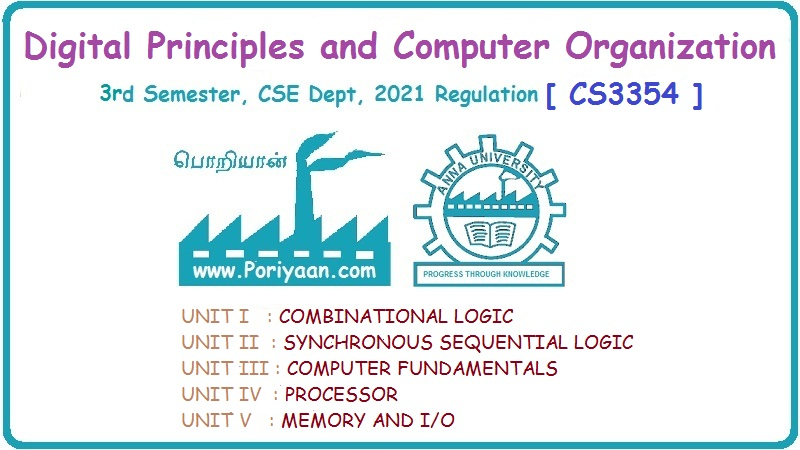Digital Principles and Computer Organization: Unit IV: Processor
Handling Control Hazards
Processor - Digital Principles and Computer Organization
To reduce the effect of cache miss or branch penalty, many processors employ sophisticated fetch units that can fetch instructions before they are needed and put them in a queue.
Handling Control Hazards
May-08,09,10,11,13,14,18,
Dec.-07,08,16,18
Instruction Queue and Prefetching
• To reduce the effect of cache miss or
branch penalty, many processors employ sophisticated fetch units that can fetch
instructions before they are needed and put them in a queue. This is
illustrated in Fig. 7.11.1.

• A separate unit called dispatch unit
takes instructions from the front of the queue and sends them to execution
unit. It also performs the decoding function.
• The fetch unit attempts to keep the
instruction queue filled at all times to reduce the impact of occasional delays
when fetching instructions during cache miss.
• In case of data hazard, the dispatch
unit is not able to issue instructions from the instruction queue. However, the
fetch unit continues to fetch instructions and add them to the queue.
Use of instruction queue during branch
instruction
• Fig. 7.11.2 shows instruction time
line. It also shows how the queue length changes over the clock cycles. Every
fetch operation adds one instruction to the queue and every dispatch unit
operation reduces the queue length by one. Hence, the queue length remains the
same for the first four clock cycles.
• The instruction I has 2-cycle stall. In
these two cycles fetch unit adds two instructions but dispatch unit does not
issue any instruction. Due to this, the queue length rises to 3 in clock cycle
6.

• Since I5 is a branch
instruction, instruction I6 is discarded and the target instruction
of I5, IK is fetched in cycle 7. Since I6 is
discarded, normally there would be stall in cycle 7; however, here instruction I4
is dispatched from the queue to the decoding stage.
• After discarding I6, the
queue length drops to 1 in cycle 8. The queue length remains one until another
stall is encountered. In this example, instructions I1, I2,
I3, I4 and IK complete execution in successive
clock cycles. Hence, the branch instruction does not increase the overall
execution time.
Branch Folding
• The technique in which instruction
fetch unit executes the branch instruction (by computing the branch address)
concurrently with the execution of other instructions is called branch folding.
• Branch folding occurs only if there
exists at least one instruction in the queue other than the branch instruction,
at the time a branch instruction is encountered.
• In case of cache miss, the dispatch
unit can send instructions for execution as long as the instruction queue is
not empty. Thus, instruction queue also prevents the delay that may occur due
to cache miss.
Approaches to Deal
• The conditional branching is a major
factor that affects the performance of instruction pipelining. There are
several approaches to deal with conditional branching.
• These are:
• Multiple streams
• Prefetch branch target
• Loop buffer
• Branch prediction.
Multiple streams
• We know that, a simple pipeline suffers
a penalty for a branch instruction. To avoid this, in this approach they use
two streams to store the fetched instruction. One stream stores instructions
after the conditional branch instruction and it is used when branch condition
is not valid.
• The other stream stores the instruction
from the branch address and it is used when branch condition is valid.
• Drawbacks :
• Due to multiple streams there are
contention delays for access to registers and to memory.
• Each branch instruction needs
additional stream.
Prefetch branch target
• In this approach, when a conditional
branch is recognized, the target of the branch is prefetched, in addition to
the instruction following the branch. This already fetched target is used when
branch is valid.
Loop buffer
• A loop buffer is a small very high speed memory. It is used to store recently prefetched instructions in sequence. If conditional branch is valid, the hardware first checks whether the branch target is within the buffer. If so, the next instructions are fetched from the buffer, instead of memory avoiding memory access.
• Advantages:
• In case of conditional branch,
instructions are fetched from the buffer saving memory access time. This is
useful for loop sequences.
• If a branch occurs to a target just a
few locations ahead of the address of the branch instruction, we may find
target in the buffer. This is useful for IF-THEN-ELSE-ENDIF sequences.
Delayed branch
• The location following a branch
instruction is called a branch delay slot. There may be more than one branch
delay slot, depending on the time it takes to execute a branch instruction.
• There are three ways to fill the delay
slot :
1. The delay slot is filled with an independent
instruction before branch. In this case performance always improves.
2. The delay slot is filled from the
target branch instructions. Performance improves if only branch is taken.
3. The delay slot is filled with an
instruction which is one of the fall through instruction. In this case
performance improves if branch is not taken.
• These above techniques are called
delayed branching.
Branch Prediction
• Prediction techniques can be used to
check whether a branch will be valid or not valid. These techniques reduce the
branch penalty.
• The common prediction techniques are:
• Predict never taken
•Predict always taken
• Predict by opcode

• Taken/Not taken switch
• Branch history table
• In the first two approaches if
prediction is wrong a page fault or protection violation error occurs. The
processor then halts prefetching and fetches the instruction from the desired
address.
• In the third prediction technique, the
prediction decision is based on the opcode of the branch instruction. The
processor assumes that the branch will be taken from certain branch opcodes and
not for others.
• The fourth and fifth prediction
techniques are dynamic; they depend on the execution history of the previously
executed conditional branch instruction.
Branch Prediction Strategies
• There are two types of branch
prediction strategies :
• Static branch strategy
• Dynamic branch strategy.
Static Branch Strategy:
In this strategy branch can be predicted based on branch code types statically.
This means that the probability of branch with respect to a particular branch
instruction type is used to predict the branch. This branch strategy may not
produce accurate results every time.
Dynamic Branch Strategy:
This strategy uses recent branch history during program execution to predict
whether or not the branch will be taken next time when it occurs. It uses
recent branch information to predict the next branch. The recent branch
information includes branch prediction statistics such as:
T: Branch taken
N: Not taken
NN: Last two branches not taken
NT: Not branch taken and previous takes
TT: Both last two branch taken
TN: Last branch taken and previous not
taken
• The recent branch information is stored
in the buffer called Branch Target Buffer (BTB).
• Along with above information branch
target buffer also stores the address of branch target.
• Fig. 7.11.4 shows the organization of
branch target buffer.

• Fig. 7.11.5 shows a typical state
diagram used in dynamic branch prediction.
• This state diagram allows backtracking
of last two instructions in a given program. The branch target buffer entry
contains the backtracking information which guides the prediction.
• The prediction information is updated
upon completion of the current branch.

•To make branch overhead zero, the
branch target buffer is extended to store the target instruction itself and a
few of its successor instructions. This allows processing of conditional
branches with zero delay.
Example 7.11.1
The following sequence of instructions are executed in the basic 5-stage
pipelined processor :
1w$1, 40($6)
add $6, $2, $2
sw $6, 50($1)
Indicate dependence and their type. Assuming there is no forwarding in this pipelined processor, indicate hazards and add NOP instructions to eliminate them. AU: Dec.-18, Marks 6
Solution:
a) I1: 1W $1, 40($6): Raw dependency on $1 from I1 to I3
I2: add $6, $2, $2 : Raw dependency on
$6 from I2 to I3
I3: SW $6 ($1): WAR dependency on $6
from I1 to I2 and I3
b) In the basic five-stage pipeline WAR
dependency does not cause any hazards. Assuming there is no forwarding in this
pipelined processor RAW dependencies cause hazards if register read happens in
the second half of the clock cycle and the register write happens in the first
half. The code that eliminates these hazards by inserting nop instruction is:
1w $1, 40($6)
add $6, $2, $2
nop; delay 13 to avoid RAW hazard on $1
from I1'
SW $6, 50($1)
Example 7.11.2
A processor has five individual stages, namely, IF, ID, EX, MEM, and WB and
their latencies are 250 ps, 350 ps, 150 ps, 300 ps, and 200 ps respectively.
The frequency of the instructions executed by the processor are as follows;
ALU: 40%, Branch 25 %, load: 20% and store 15% What is the clock cycle time in
a pipelined and non-pipelined processor? If you can split one stage of the
pipelined datapath into two new stages, each with half the latency of the
original stage, which stage would you split and what is the new clock cycle
time of the processor? Assuming there are no stalls or hazards, what is the
utilization of the data memory? Assuming there are no stalls or hazards, what
is the utilization of the write register port of the "Registers"
unit? AU Dec.-18, Marks 6
Solution:
a) Clock cycle time in a pipelined processor=350 ps
Clock cycle time in non-pipelined
processor
= 250 ps +350 ps + 150 ps + 300 ps + 200
ps= 1250 ps
b) We have to split one stage of the
pipelined datapath which has a maximum latency i.e. ID.
After splitting ID stage with latencies
ID1 = 175 ps and ID2 = 175 ps we have new
clock cycle time of the processor equal
to 300 ps.
c) Assuming there are no stalls or
hazards, the utilization of the data memory = 20% to 15 % = 35%.
d) Assuming there are no stalls or
hazards, the utilization of the write-register port
of the register unit = 40 % + 25 %=65%
Review Questions
1. What is branch hazard? Describe the methods
for dealing with the branch hazards. AU May-08, Marks 10
2. Highlight the solutions of
instruction hazards. AU: Dec.-07, Marks 8
3. Discuss in detail about hazards due to unconditional branching. AU: Dec.-08, Marks 10
4. What is instruction hazard? Explain
the methods for dealing with the instruction hazards. AU May-10, Marks 16
5. What are the hazards of conditional
branches in pipelines ? how it can be resolved? AU May-11, Marks 16
6. Describe the techniques for handling control hazards in pipelining. AU: May-13, Marks 10
7. Distinguish between static and dynamic branch prediction approaches. AU May-09, 13, Marks 2
8. Explain dynamic branch prediction
technique. AU May-13, Marks 6
9. Discuss the methods to reduce hazards due to conditional branches. AU May-14, Marks 16
10. Why is branch prediction algorithm
needed? Differentiate between the static and dynamic techniques. AU: Dec.-16,
Marks 13
Digital Principles and Computer Organization: Unit IV: Processor : Tag: : Processor - Digital Principles and Computer Organization - Handling Control Hazards
Related Topics
Related Subjects
Digital Principles and Computer Organization
CS3351 3rd Semester CSE Dept | 2021 Regulation | 3rd Semester CSE Dept 2021 Regulation
